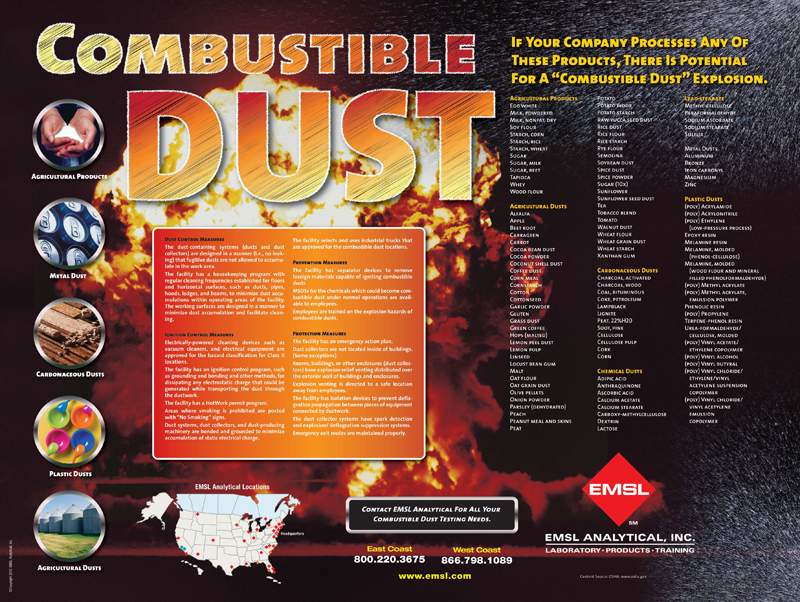How is combustible dust tested?
Combustible dust analysis consists of a series of tests
both to determine particle size and moisture content,
and to calculate how potentially “explosive” the dust
is. The sampling part is actually fairly simple — dust
is carefully collected using a brush and put into a
glass or plastic jar. It is suggested to collect samples
from the appropriate areas in the production areas and
also from elevated surfaces. A sample consisting of 1
kilogram of dust must be collected and submitted to the
lab for analysis. Air sampling is not necessary to
determine whether or not a dust is combustible.
For combustible dust sampling and analysis, EMSL recommends
following the OSHA ID-201SG sampling method guideline.
The OSHA Combustible Dust Emphasis Program (CPL
03-00-008) also provides information on sample
collection.
Combustible dust is typically
analyzed by a suite of testing:
Initial Dust Characterization
Determines particle size and moisture content. The most
important information determined in this stage are
Percent Combustible Dust. This is the percentage of the
sample that has the potential to be combustible when it
is dry and fine enough to pass through a 40 mesh sieve
(less than 420 μm in size). The testing includes:
• Percent through 40 Mesh Screen
• Percent Moisture Content
• Percent Combustible Material (calculated)
• Percent Combustible Dust (calculated)
Go – No Go Testing (Explosive
Screening) – ASTM E1226
This is an economical and practical way to determine if the
dust in the sample has the potential to be explosive.
Testing consists of exposing the fine dust in the sample
to low energy igniters inside the 20-Liter Siwek
explosion chamber and determine the explosion
overpressure. If the dust is not found to be an
explosive threat, the analysis can be aborted to avoid
unnecessary fees. If the sample turns out to be
explosive on the screen testing, the more comprehend
analyses listed below should be conducted.
Explosion Severity (Kst, Pmax,
[dP/dt]max) – ASTM E1226
This testing provides an indication of the severity of the
dust explosion by determining the deflagration
parameters. The larger the value of Kst, the more severe
the explosion is. For this test, the dust is suspended
and ignited in the Siwek chamber and the maximum
pressure and the rate of pressure rise are measured.
Minimum Explosion Concentration
(MEC) – ASTM E1515
MEC is the minimum concentration for explosivity of a
combustible dust cloud. It is determined by suspending
the dust in the Siwek Chamber.
Minimum Ignition Energy (MIE) –
ASTM E2019
MIE is the electrical energy discharged from a capacitor,
just sufficient to produce the ignition of the most
ignitable mixture of air and dust. It is determined by
suspending the dust in a Hartmann Lucite explosion
chamber.
Minimum Ignition Temperature
Test (MIT) – ASTM E1491 (dust-cloud)ASTM E2021 (dust
layer)
This test method covers the minimum temperature at which a
dust cloud will autoignite when exposed to air and
heated in a furnace at atmospheric pressure. It is
determined by introducing the dust into a BAM oven. As
an alternative, the minimum temperature of self-ignition
of dust layer can be measured using a hot plate set-up.
Class II Testing
This level of testing involves a number of parameters that
determine if the sampled dust is considered a Class II
hazardous material. Class II locations are defined as
locations with combustible dust having Ignition
Sensitivity(I.S.) greater than or equal to 0.2 or
Explosion Severity (E.S.) greater than or equal to 0.5.
I.S. is calculated from MIT, MIE, and MEC for the sample
normalized to Pittsburg coal dust, whereas E.S. is
calculated from Pmax and [dP/dt] max for the sample,
also normalized to Pittsburg coal dust.
Resistivity Testing (for metal
dust in particular)
The resistivity testing is particularly important for metal
dust. The electrical nature of the dust is one criteria
to determine if it is necessary to take special
precaution with regard to electrical insulation of the
equipment operating in a location with Class II dust.
FREE Combustible Dust Poster Page
Download 8.5
X 11 PDF
Request a
16”
x 24” Copy



















